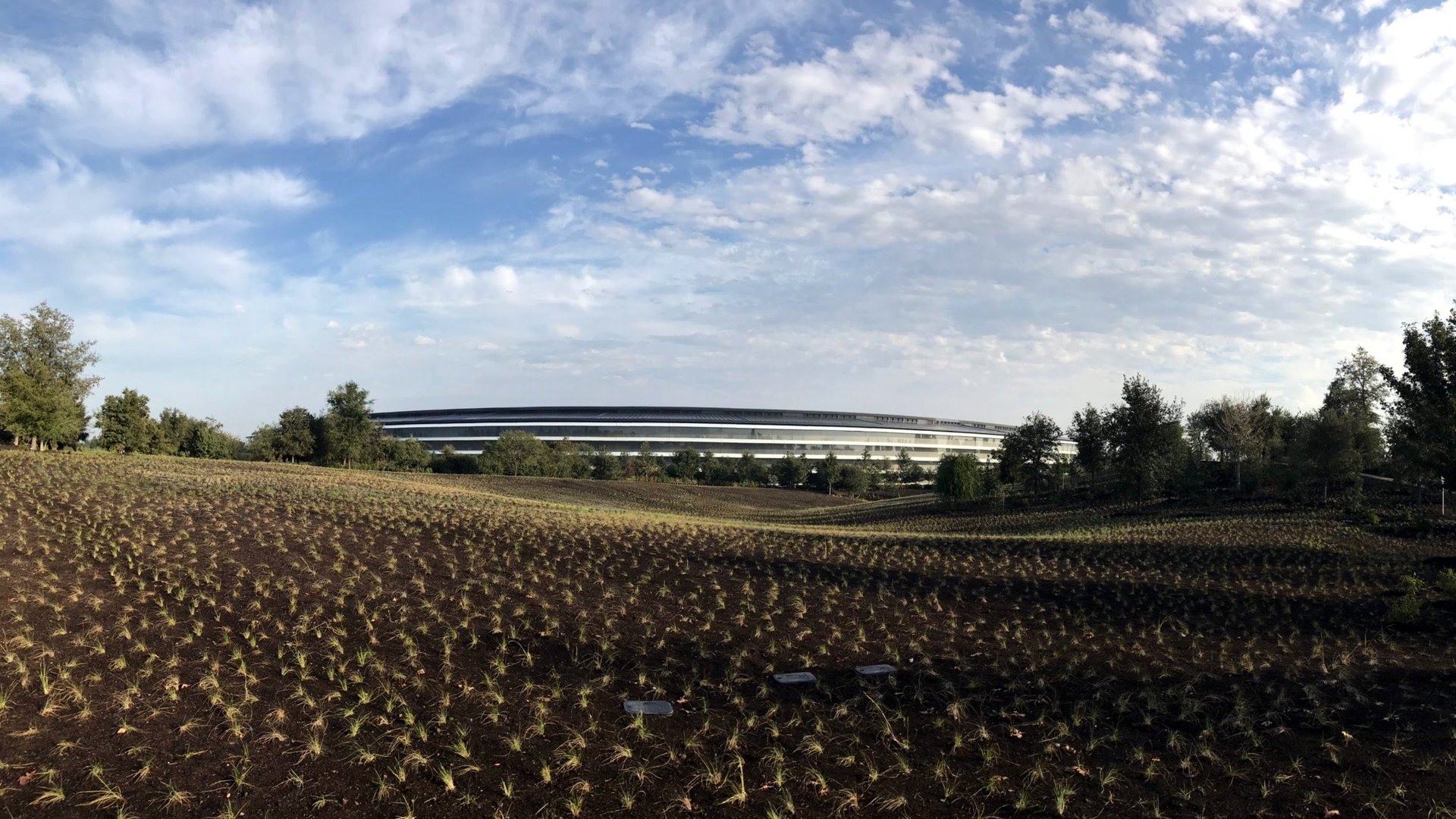The Apple employees’ complaint letter is also a road map for reopening offices
When Apple unveiled its new, 175-acre campus in 2017, the project was lauded for its elegant, minimalist architecture and eco-friendly features. Apple Park’s bespoke chairs and elevator buttons, its nearly three-story-high sliding glass doors in the cafeteria, the distressed stone in the yoga studio, the massive spaceship-like Ring building—it all made sense for a company that had built its reputation on forward-thinking design.


When Apple unveiled its new, 175-acre campus in 2017, the project was lauded for its elegant, minimalist architecture and eco-friendly features. Apple Park’s bespoke chairs and elevator buttons, its nearly three-story-high sliding glass doors in the cafeteria, the distressed stone in the yoga studio, the massive spaceship-like Ring building—it all made sense for a company that had built its reputation on forward-thinking design.
However, something was off, as Quartz’s then tech editor Mike Murphy reported at the time. “Every surface, every path, every plain, and every sightline on Apple Campus has been considered. Materials were agonized over,” he wrote after a visit. “But what I don’t get, after spending far more hours wandering around a glass cathedral in the middle of Silicon Valley, is why.” He wondered, was this even a place where employees would enjoy working? “So much seems to have been considered about Apple’s campus,” he wrote, “apart from what it’s really for.”
The $5 billion headquarters, planned by Apple’s legendary founder Steve Jobs, was supposed to speak to Apple’s long-term future, but it apparently wasn’t speaking to employees’ early 21st century needs. According to rumors, Apple employees were walking into glass walls and injuring themselves. Critics noted the campus was missing a daycare. Engineers didn’t like the open-plan office.
And now, four years and one pandemic later, Apple employees are staging a revolt against a new policy recalling them to the office.
Not even splashy campuses are better than working from home

The pandemic has made even the most luxurious of tech campuses—with free or subsidized meals or climbing walls—less relevant, now that people have proven that they can work productively from home. What hasn’t changed, it seems, is Apple’s tendency to ignore what employees want most in their work environment and structure.
On June 2, Apple CEO Tim Cook announced that the company expected to see everyone back in their offices in early September, at which time employees must begin working in the office three days per week, on Mondays, Tuesdays, and Thursdays. This was an evolution from the company’s pre-pandemic stance of discouraging remote work. But for some employees, it wasn’t enough.
Two days after the announcement, a group of employees complained, as The Verge reported. They responded to Cook’s edict with a friendly but detailed letter asking the leadership team to reconsider its policy. (The letter started life in a Slack channel with more than 2,800 members who support remote work; it was written and edited by about 80 employees, according to The Verge.)
The employees thanked the company for considering new rules for its more than 100,000 workers, but they still wanted more freedom, more flexibility to work from anywhere, on the schedules that work best for them, they said.
As thousands of companies plan to reopen with similar hybrid models, the complaint letter from Apple’s staff is quite instructive. It incorporates much of the best advice the organizational psychologists and other experts have been offering about the next big transition out of the pandemic into a new, work-from-anywhere era.
What Apple got right and wrong
To be sure, Apple was not out of the norm in landing on a three-day per week office schedule, which seems to be the sweet spot for most employees, according to multiple surveys. People want to have the ability to focus on work from home—and to reconnect with others for brainstorming meetings and socializing, as needed. The company’s mistake, it seems, was to insist that everyone head back, and on set days chosen by the company.
“For many of us at Apple, we have succeeded not despite working from home, but in large part because of being able to work outside the office,” the letter stated. “The last year has felt like we have truly been able to do the best work of our lives for the first time, unconstrained by the challenges that daily commutes to offices and in-person co-located offices themselves inevitably impose; all while still being able to take better care of ourselves and the people around us.”
Another apparent misstep on Apple’s part was to assume that leadership understood what employees wanted, or to use that as cover for its own agenda. The letter notes:
Over the last year we often felt not just unheard, but at times actively ignored. Messages like, “we know many of you are eager to reconnect in person with your colleagues back in the office,” with no messaging acknowledging that there are directly contradictory feelings amongst us feels dismissive and invalidating.
Employees already feel connected to their colleagues around the globe, the authors wrote, if not more connected than before the pandemic. “We’ve come to look forward to working as we are now, without the daily need to return to the office,” they said.
How true flexibility supports diversity and equity
Among the company-wide benefits of staying fully flexible, the employees cited diversity and inclusion in retention and hiring, arguing:
We are living proof that there is no one-size-fits-all policy for people. For Inclusion and Diversity to work, we have to recognize how different we all are, and with those differences, come different needs and different ways to thrive. We feel that Apple has both the responsibility to recognize these differences, as well as the capability to fully embrace them.
Apple is already a distributed company with offices around the world, the authors point out, and allowing some people to work remotely full-time would also give the company access to skilled people who can’t or won’t live in an urban center. This is one of the biggest promises of remote or hybrid work, one that is already dramatically shifting the ways companies hire, says Tsedal Neeley, Harvard Business School professor and remote work expert.
To be sure, some experts are concerned that if too many people from underrepresented communities choose to work from home, it could negatively impact their rate of promotions and pay increases, and make future leadership teams less diverse, since people who show up at work are probably still going to be the people to be promoted. It’s something many workplaces are going to need to monitor. But working from home also has benefits. For people of color, it can mean getting through the day with fewer microaggressions from colleagues. For people with disabilities, it can mean avoiding a daily commute or an office space that might be hard to navigate physically or mentally, all of which might factor into their ability to contribute fully or even maintain employment.
Following a recent rather discouraging report by LinkedIn on the experiences of LGBTQ+ employees in the workplace, where many still feed the need to hide their identities, Rosanna Durruthy, LinkedIn’s head of global diversity, inclusion, and belonging, said that it’s up to companies “to create the psychological safety for an individual to manage what life throws [at them] while at the same time being productive and contributing to the organization.”
To figure out what’s best for underrepresented employees, she says, “companies need to make people a part of that decision” by “building an environment that supports the unique experiences people have” and recognizing that includes where they live and work.
In other words, it means doing exactly what Apple’s employees have asked for.
The wish list for hybrid work policies
The Apple employees’ list of specific requests are extremely telling, so useful that other companies could adopt as a road map to going hybrid. Here’s what they said:
- We are formally requesting that Apple considers remote and location-flexible work decisions to be as autonomous for a team to decide as are hiring decisions
- We are formally requesting a company-wide recurring short survey with a clearly structured and transparent communication / feedback process at the company-wide level, organization-wide level, and team-wide level, covering topics listed below.
- We are formally requesting a question about employee churn due to remote work be added to exit interviews.
- We are formally requesting a transparent, clear plan of action to accommodate disabilities via onsite, offsite, remote, hybrid, or otherwise location-flexible work.
- We are formally requesting insight into the environmental impact of returning to onsite in-person work, and how permanent remote-and-location-flexibility could offset that impact.
The old ways of working didn’t work well for everyone
What’s happened at Apple and elsewhere is that “people have had 18 months to realize the nature and magnitude of the sacrifices that they had to make, and the consequences of those sacrifices in order to do work the way we used to do it,” says Lindsay Lagreid, a senior advisor at Limeade Institute, the research arm of the Limeade employee experience software company.
She says the old way actually didn’t work well for most people. “It worked for certain people in positions of privilege and power,” she notes, but the vast majority of people are not prepared to go back to sleeping less, commuting more, spending less time with family and children, and having less time or freedom to care for themselves or others.
“That’s one thing that’s frustrating. I am a little surprised at how often I hear the word ‘return’ because return implies that what we were doing before worked pretty well.”
Most companies who are calling employees back to a structured, in-office work model say they’re concerned with innovation and creativity. The best ideas happen when people have “spontaneous collisions,” they insist, and thus the workday should be set up for people to run into each other in the hallway or to chat casually over coffee. The late Steve Jobs was known for his faith in this concept, so it’s not that surprising that an in-office culture lives on at Apple.
But this is a “once-in-a-century opportunity” to rethink how we work and how to make it a positive experience for the maximum number of people, Lagreid argues. “The irony is the answer is actually pretty simple if you trust your people and give them the freedom and flexibility that they’ve had for the last 18 months to make decisions about when and where and how they do their work. Problem solved.”